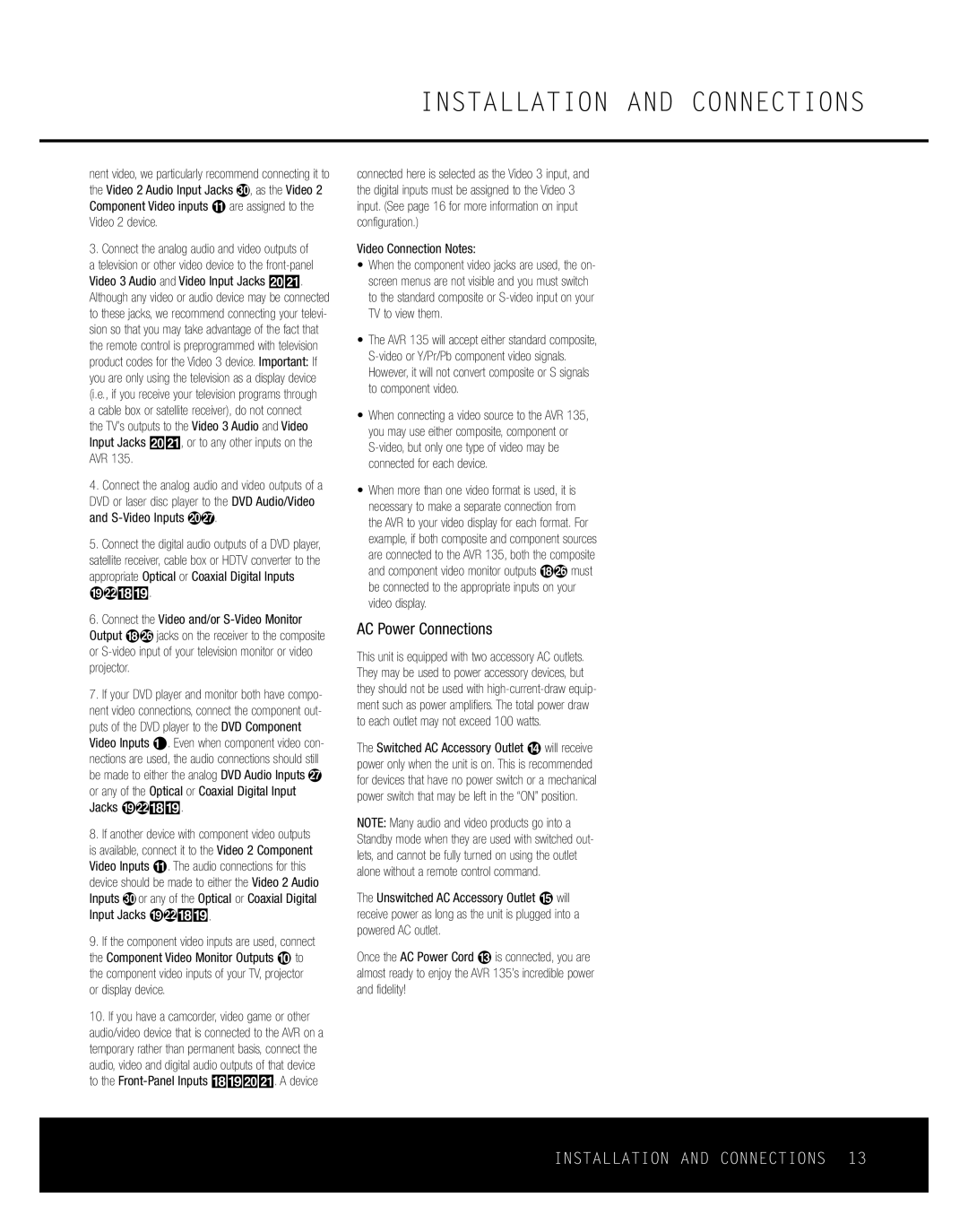
INSTALLATION AND CONNECTIONS
nent video, we particularly recommend connecting it to the Video 2 Audio Input Jacks k, as the Video 2 Component Video inputs ⁄ are assigned to the Video 2 device.
3.Connect the analog audio and video outputs of a television or other video device to the
Although any video or audio device may be connected to these jacks, we recommend connecting your televi- sion so that you may take advantage of the fact that the remote control is preprogrammed with television product codes for the Video 3 device. Important: If you are only using the television as a display device (i.e., if you receive your television programs through a cable box or satellite receiver), do not connect
the TV’s outputs to the Video 3 Audio and Video Input Jacks ÓÔ, or to any other inputs on the AVR 135.
4.Connect the analog audio and video outputs of a DVD or laser disc player to the DVD Audio/Video and
5.Connect the digital audio outputs of a DVD player, satellite receiver, cable box or HDTV converter to the appropriate Optical or Coaxial Digital Inputs ·c*(.
6.Connect the Video and/or
7.If your DVD player and monitor both have compo- nent video connections, connect the component out- puts of the DVD player to the DVD Component Video Inputs ¤. Even when component video con- nections are used, the audio connections should still be made to either the analog DVD Audio Inputs h or any of the Optical or Coaxial Digital Input Jacks ·c*(.
8.If another device with component video outputs
is available, connect it to the Video 2 Component Video Inputs ⁄. The audio connections for this device should be made to either the Video 2 Audio Inputs kor any of the Optical or Coaxial Digital Input Jacks ·c*(.
9.If the component video inputs are used, connect the Component Video Monitor Outputs ‚ to the component video inputs of your TV, projector or display device.
10.If you have a camcorder, video game or other audio/video device that is connected to the AVR on a temporary rather than permanent basis, connect the audio, video and digital audio outputs of that device to the
connected here is selected as the Video 3 input, and the digital inputs must be assigned to the Video 3 input. (See page 16 for more information on input configuration.)
Video Connection Notes:
•When the component video jacks are used, the on- screen menus are not visible and you must switch to the standard composite or
•The AVR 135 will accept either standard composite,
•When connecting a video source to the AVR 135, you may use either composite, component or
•When more than one video format is used, it is necessary to make a separate connection from the AVR to your video display for each format. For example, if both composite and component sources are connected to the AVR 135, both the composite and component video monitor outputs °g must be connected to the appropriate inputs on your video display.
AC Power Connections
This unit is equipped with two accessory AC outlets. They may be used to power accessory devices, but they should not be used with
The Switched AC Accessory Outlet › will receive power only when the unit is on. This is recommended for devices that have no power switch or a mechanical power switch that may be left in the “ON” position.
NOTE: Many audio and video products go into a Standby mode when they are used with switched out- lets, and cannot be fully turned on using the outlet alone without a remote control command.
The Unswitched AC Accessory Outlet fi will receive power as long as the unit is plugged into a powered AC outlet.
Once the AC Power Cord ‹ is connected, you are almost ready to enjoy the AVR 135’s incredible power and fidelity!
INSTALLATION AND CONNECTIONS 13
